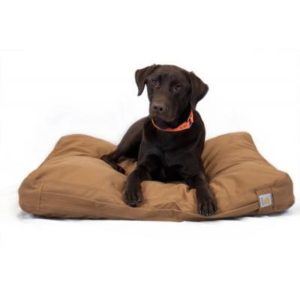Crate Training Basics
 Crate training is one of the most misunderstood subjects in your pup/dog’s world. Folks may think that a crate is a horrible punishment – a jail used to confine your dog when he has been bad. In reality, dogs, like their wolf ancestors, are den animals. They feel secure and cozy in their dens, and the crate acts as a safe harbor in times of stress when dogs just need a break from us and all the frantic activity that seem to follow their humans.
Crate training is one of the most misunderstood subjects in your pup/dog’s world. Folks may think that a crate is a horrible punishment – a jail used to confine your dog when he has been bad. In reality, dogs, like their wolf ancestors, are den animals. They feel secure and cozy in their dens, and the crate acts as a safe harbor in times of stress when dogs just need a break from us and all the frantic activity that seem to follow their humans.
Crates also serve a practical purpose of keeping your dog safe from harm when you are unable to be with them, and they can be an invaluable aid during potty training.
FAIRNESS IN ALL THINGS
Although the crate is a wonderful training tool, when used incorrectly it can actually be detrimental to your pet.
- If you are at work all day and then come home and only let your dog out for short periods of time then the den becomes a prison.
- If you keep your dog in a crate all the time and do not let it exercise and interact with the family, it will soon become frustrated. This can lead to destructive behaviors.
- It is never fair to leave a puppy or dog in its crate past the amount of time that he can control his bladder.
CHOOSING THE PROPER DEN
Selecting the right crate for your pet is critical to your success. Too small and your pet will feel trapped and uncomfortable; too big and is loses its den-like appeal. Here are some basic tips to help you pick a crate:
- The crate should be large enough for the dog to sit, stand, stretch out and turn around comfortably.
- Choose a crate that can accommodate the puppy when he is full grown. (So you don’t have to buy another crate every few months.) While your puppy is small, create a barrier within the crate to make it temporarily smaller. Some wire and plastic crates come with a divider, but it is also easy to create a makeshift divider by blocking excess space with a box or bedding.
- Keep in mind that if a puppy has enough room to go to the back of the crate to potty then return to the front to eat and sleep, he will have accidents in his crate. The space should be limited.
PROPER INTRODUCTION IS THE KEY TO SUCCESS.
Most dog crate nightmare stories are caused by taking a new dog and just putting him into the crate without a proper introduction. Making the crate a place the dog wants to go – rather than stuffing the dog into its new home and closing the door – is critical.
This is an “Any behavior that is rewarded will be repeated moment.” So use this to your advantage.
- Place your crate in an area where your family will be spending a lot of time.
- Put a soft blanket or towel in the crate. Never use a dog pillow until you are sure that it will not become a chew toy. If your dog eats its bed, you may have an emergency vet visit in your future!
- Have lots of toys and soft yummy treats on hand.
- Sit about 2 feet from the crate and encourage the dog to approach. Say the dog’s name, clap your hands, make kissing noises – whatever it takes to get the dog’s attention.
- Do not use the word “come” unless you are sure that the dog will respond to it. We want praise the dog for approaching the crate not for “coming”. If your pet does not come toward you when called, you can try to lure him in with treats, praising every forward advance.
- When your dog is comfortable being in close proximity to the crate, place the treat on the floor next to the crate. Every time your dog gets near the treats praise or click. Do not wait for him to take the treat.
- The next step is to get your dog comfortable with touching the crate. Start by placing a treat that touches the crate.
- Make a trail of treats to the open door. Praise every forward motion as your dog is scarfing down the goodies.
- Next, toss a few goodies in the crate door. Your dog should follow them in even if they are a bit shy; just give it time. Do not force the behavior, and praise every forward movement.
- Now that your dog is familiar with the crate, let’s make going in a lot of fun! Start a game with your dog’s favorite toy by tossing the toy into the crate. You can add treats, if necessary. Continue this process until your pup is running happily in and out of the crate.
- After your dog has mastered going in and out of his crate, you can add a word/command. Some people use “crate” or “kennel”. It does not matter what you call it but add a word to all behaviors. It will help you communicate with your friend.
Whew, this has been a lot of work. This is probably a good time to take a break and do something else for a few minutes. When you are ready to resume their lessons go back a few steps and toss a favorite toy or treats into their crate. Make a fun game out of this, as what puppy can resist playing a game with you. You’re just reinforcing your earlier lesson.
The next hurdle is teaching your dog to be comfortable in the crate with the door closed.
- Once your dog is running in and out of the crate reliably, toss in a cookie and a great chew toy.
- Close the crate door and wait about 30 seconds. Open the door and reward your pup.
- Never open the door while your dog is whining or trying to get out as he learns very quickly to howl longer and louder until you give in and open the door. If your dog exhibits this behavior and is not stopping then actually get up and leave the room until the temper tantrum subsides. Always wait until your puppy is quiet before you open the door.
- After you let your dog out, play for a moment letting him start running in and out of the crate again. Close the door again and wait two minutes to open it.
- Repeat this increasing the time to five minutes with you sitting beside the crate.
Depending on your pup and the amount of time this has taken you to get the five minutes quiet in their den, it might be beneficial to take another break.
- When you begin the exercise again just repeat the above procedure but this time after closing the door leave the room for a couple of minutes. Be sure that you are out of sight.
- Wait to be sure that your pup is quiet and return and release them.
- Do this on and off during the day increasing the time your little buddy is left alone in small increments.
HELPFUL TIPS
- If your dog starts to whine and cry to be let out you may have increased the length of time too quickly. Next time, try leaving him in the crate for a shorter time period.
- Do not release your dog from the crate until he is quiet. Dogs learn very quickly, and they will know that tantrums work and are the best way to get you to open the door.
- Have high value chew toys to use just at crate time. A frozen stuffed kong can keep your pup happy for a very long time.
- Keep the crate door open when your dog isn’t in it. Your dog may use this a space to rest or recuperate during the day.
- Implement a 2-foot-rule so that when your dog goes into the crate no one is allowed to go within two feet. This is a courtesy to your dog.
- Reduce liquid intake before long periods of crate confinement. A puppy that is healthy can be taken off water about an hour before bedtime to reduce the likelihood of needing to go in the middle of the night, but if you feel that your dog may need water during the night, you can put ice cubes in a dish to regulate the amount of fluid intake.
- Feed your dog in it’s crate. This makes the crate a very desirable space.
- If you leave your dog in a crate when you are away from home, it helps to continue to crate him for short periods of time when you are home. This prevents them from associating the crate with being left alone.
- It may be useful to crate your dog ten to fifteen minutes before leaving the house. This prevents separation anxiety behavior in the crate because the dog will not equate being put in the crate to leaving him alone.
- Do not make a big deal out of coming home or leaving the house as this will increase the possibility of separation anxiety.

 nto your home you must set them up for success. Those first hours or days with a new pet are stressful for both you and the dog!
nto your home you must set them up for success. Those first hours or days with a new pet are stressful for both you and the dog! signal that it needs to go and to wait until he can get to an “approved” potty location. During training, you’ll need to read subtle clues and proactively encourage your dog to potty regularly.
signal that it needs to go and to wait until he can get to an “approved” potty location. During training, you’ll need to read subtle clues and proactively encourage your dog to potty regularly.

